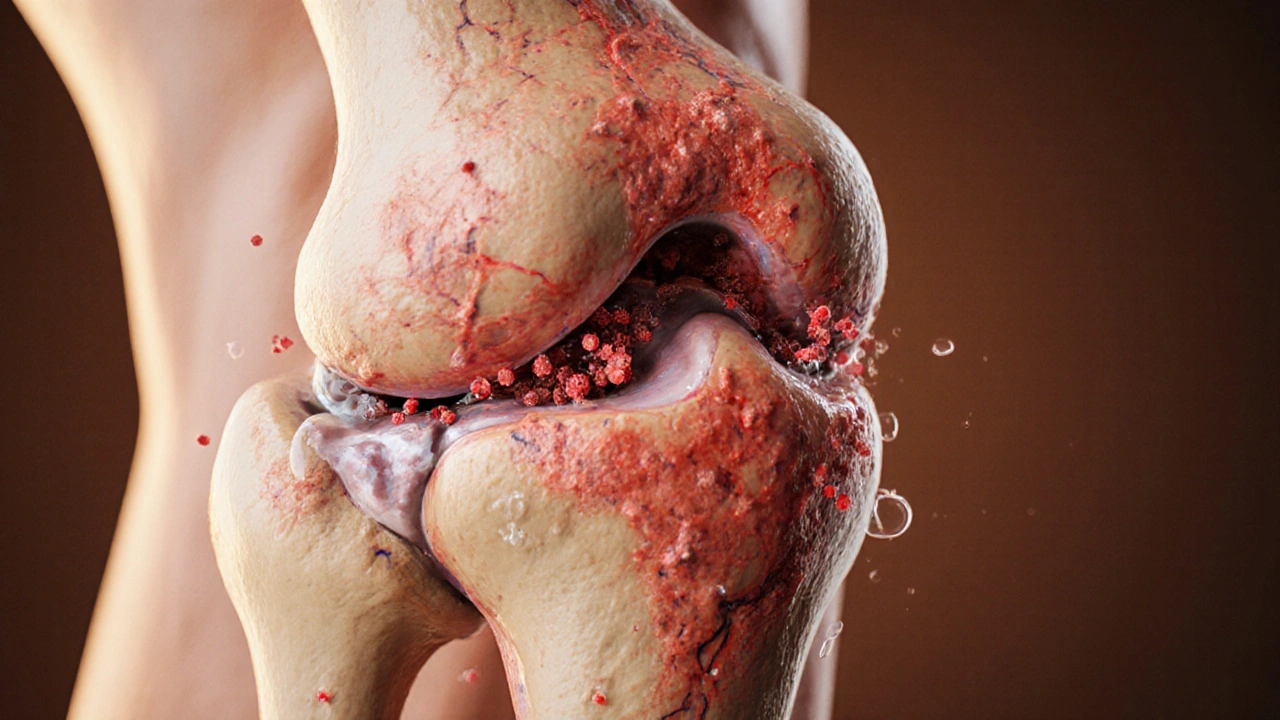
Arthritis Type Comparison Tool
Understand Your Arthritis Type
Compare key characteristics of rheumatoid arthritis (RA) and osteoarthritis (OA) to better understand your symptoms and treatment options.
| Feature | Rheumatoid Arthritis (RA) | Osteoarthritis (OA) |
|---|---|---|
| Root cause |
Autoimmune attack on synovium Cytokines like TNF-α and IL-6 drive inflammation |
Mechanical wear of cartilage Cartilage degeneration over time |
| Typical age of onset | 30-60 years | 50+ years |
| Joint pattern | Symmetrical, often hands, wrists, feet | Asymmetrical, weight-bearing joints |
| Inflammatory signs | Morning stiffness >1 hour, swelling | Stiffness after rest, no swelling |
| Treatment approach | DMARDs target underlying inflammation Biologics reduce cytokine activity |
NSAIDs for pain relief Weight management and exercise help |
| Progression | Can progress rapidly, leading to joint damage | Progresses slowly over years |
How Inflammation Affects Your Joints
Chronic inflammation (like in RA) creates a destructive cycle where immune cells attack healthy tissue, leading to joint erosion. This differs from OA, where inflammation is typically a secondary effect of cartilage wear.
Understanding your specific condition helps you choose the right treatment:
- For RA: Focus on reducing inflammatory cytokines
- For OA: Focus on reducing joint stress and managing pain
Key Takeaways
- Inflammation is a normal immune response, but when it becomes chronic it can erode joint tissue.
- Rheumatoid arthritis (RA) and osteoarthritis (OA) differ in cause, pattern, and treatment.
- Cytokines such as TNF‑α and IL‑6 drive the destructive cycle in RA.
- NSAIDs relieve pain, while DMARDs target the underlying inflammation.
- Diet, weight management, and regular low‑impact exercise can blunt inflammatory signals.
What Is Inflammation?
Inflammation is the body’s immediate reaction to injury, infection, or irritants. It mobilises immune cells, increases blood flow, and releases chemicals that help clear damaged tissue. When the stimulus disappears, the process shuts down. The problem kicks in when the alarm stays on, turning a short‑term defence into a long‑term assault on healthy tissue.
Understanding Arthritis
Arthritis refers to a group of more than 100 conditions that cause joint pain, swelling, and reduced motion. The two most common forms are rheumatoid arthritis, an autoimmune disease, and osteoarthritis, a wear‑and‑tear condition that usually appears with age.

Rheumatoid Arthritis vs Osteoarthritis
| Feature | Rheumatoid Arthritis (RA) | Osteoarthritis (OA) |
|---|---|---|
| Root cause | Autoimmune attack on synovium | Mechanical wear of cartilage |
| Typical age of onset | 30‑60 years | 50+ years |
| Joint pattern | Symmetrical, often hands, wrists, feet | Asymmetrical, weight‑bearing joints |
| Inflammatory signs | Morning stiffness >1 hour, swelling | Stiffness <30 minutes, minimal swelling |
| Primary treatment | DMARDs, biologics, low‑dose steroids | Analgesics, physical therapy, joint replacement |
How Inflammation Leads to Joint Damage
The link between chronic inflammation and arthritis lies in a cascade of cellular events. When immune cells linger in the joint, they release Cytokines such as tumor‑necrosis factor‑alpha (TNF‑α) and interleukin‑6 (IL‑6). These messengers signal the Synovial membrane to thicken and produce excess fluid, creating the classic swelling seen in RA.
At the same time, cytokines stimulate enzymes that break down Cartilage, the smooth tissue that cushions bones. As cartilage erodes, bone surfaces rub together, causing pain and further inflammation-a vicious feedback loop.
In osteoarthritis, the initial trigger is mechanical stress, but once cartilage damage occurs, low‑grade inflammation follows, perpetuating the cycle. Even though OA is less overtly inflammatory than RA, targeting inflammatory pathways can still improve symptoms.
Common Triggers That Keep Inflammation Going
- Obesity: Fat tissue releases adipokines that act like cytokines, amplifying joint inflammation.
- Smoking: Nicotine alters immune regulation and increases the risk of developing RA.
- Diet high in processed sugars and omega‑6 fatty acids: These promote prostaglandin production, a key inflammatory mediator.
- Repeated joint stress: Overuse in sports or occupations can keep the synovium irritated.

Treatment Strategies That Target Inflammation
Modern therapy distinguishes between symptom relief and disease modification.
NSAIDs (non‑steroidal anti‑inflammatory drugs) such as ibuprofen or naproxen block cyclooxygenase enzymes, reducing prostaglandin‑driven pain and swelling. They work quickly but don’t stop the underlying autoimmune process.
For disease‑modifying effects, doctors prescribe DMARDs (disease‑modifying antirheumatic drugs) like methotrexate, sulfasalazine, or leflunomide. These agents dampen cytokine production, slowing joint erosion over months.
Biologic DMARDs-e.g., etanercept (TNF‑α blocker) or tocilizumab (IL‑6 receptor antagonist)-target specific cytokines and have transformed outcomes for many RA patients.
Physical therapy, joint‑friendly exercise, and weight loss complement pharmacology by reducing mechanical stress and improving joint range of motion.
Practical Tips to Reduce Inflammation Naturally
- Eat a Mediterranean‑style diet rich in oily fish, leafy greens, nuts, and olive oil; these foods supply omega‑3 fatty acids that counteract omega‑6-driven inflammation.
- Maintain a healthy body weight; even a 5‑% loss can lower joint load and inflammatory markers.
- Incorporate low‑impact activities like swimming, cycling, or yoga to keep joints moving without excess strain.
- Limit alcohol and quit smoking; both habits heighten inflammatory pathways.
- Prioritise sleep; 7‑8 hours supports hormonal balance that regulates immune function.
When to Seek Medical Advice
If joint pain persists for more than a few weeks, is accompanied by swelling, warmth, or morning stiffness lasting over an hour, schedule an appointment. Early blood tests (RF, anti‑CCP) and imaging can differentiate RA from OA, allowing doctors to start DMARD therapy before irreversible damage occurs.
Frequently Asked Questions
Can osteoarthritis become as inflamed as rheumatoid arthritis?
Osteoarthritis can develop low‑grade inflammation, especially after cartilage loss, but it rarely shows the systemic inflammatory markers (high CRP, rheumatoid factor) typical of RA.
Are NSAIDs safe for long‑term use?
Short‑term NSAIDs are effective for pain relief, but chronic use can irritate the stomach lining, raise blood pressure, and affect kidney function. Always discuss duration and dosage with a healthcare professional.
What lifestyle changes can lower cytokine levels?
Adopting a Mediterranean diet, regular moderate exercise, maintaining a healthy weight, and quitting smoking have all been shown in clinical studies to reduce circulating TNF‑α and IL‑6.
Is there a cure for rheumatoid arthritis?
There is no cure, but modern DMARDs and biologics can put the disease into remission, preventing joint damage and allowing a near‑normal life.
How fast do DMARDs start working?
Traditional DMARDs like methotrexate usually take 6‑12 weeks to show noticeable improvement, while biologic agents may work within a few weeks.
14 Comments
Robert Gilmore October 12, 2025 AT 02:58
i guess the article is ok but kinda boring.
Robert Gilmore October 16, 2025 AT 20:51
While the exposition is thorough, it neglects the socioeconomic factors that exacerbate rheumatoid arthritis, thereby presenting an incomplete picture of disease management.
Robert Gilmore October 21, 2025 AT 14:45
Interesting points, but let’s clarify a few details. First, inflammation is indeed a double‑edged sword; it protects yet can cause collateral damage when chronic. Second, not all cytokines are equally vilified-some have regulatory roles. Finally, lifestyle interventions complement pharmacology, especially for osteoarthritis. Overall, the article provides a solid foundation.
Robert Gilmore October 26, 2025 AT 08:38
When we speak of inflammation as the catalyst of arthritis, we must dive deeper than mere surface‑level descriptions. The immune system, in its vigilant quest to heal, releases an orchestra of cytokines-TNF‑α, IL‑6, IL‑1β-each acting like a relentless drummer in a march that never ends. Over time, these molecular messengers degrade the synovial membrane, erode cartilage, and dissolve bone, turning joints into battlegrounds. This process is not a mere accident; it is a self‑sustaining vortex where damaged tissue begets more inflammation, which in turn begets more damage. Genetic predispositions amplify this cascade, explaining why some families see early‑onset rheumatoid arthritis while others never experience it. Moreover, environmental triggers-smoking, infections, even stress-can tip the delicate balance toward autoimmunity. In osteoarthritis, the story diverges: mechanical wear initiates micro‑fractures, prompting a secondary, less aggressive inflammatory response that still contributes to pain and stiffness. Yet, the chronicity differs; OA’s inflammation is often a downstream effect rather than the primary driver. Recognizing this distinction is crucial for treatment: DMARDs target the upstream cytokine storm in RA, whereas NSAIDs, physical therapy, and weight management blunt the downstream effects in OA. Ignoring these nuances leads to suboptimal care and wasted resources. Thus, inflammation is both the spark and the sustainer of arthritis’s relentless progression, demanding a nuanced, targeted therapeutic approach.
Robert Gilmore October 31, 2025 AT 02:31
That was a vivid description, Hariom. I’d add that early diagnosis paired with tailored lifestyle changes can slow down the cytokine cascade. Simple habits-like low‑impact exercise and anti‑inflammatory diets-often make a noticeable difference.
Robert Gilmore November 4, 2025 AT 20:25
For anyone new to the topic, remember that rheumatoid arthritis requires disease‑modifying drugs, not just painkillers. Osteoarthritis, on the other hand, benefits more from joint‑preserving strategies.
Robert Gilmore November 9, 2025 AT 14:18
yeah but meds cant fix everything you still gotta move
Robert Gilmore November 14, 2025 AT 08:11
It is incumbent upon clinicians to differentiate between autoimmune and degenerative etiologies prior to prescribing therapeutics, lest they exacerbate iatrogenic complications.
Robert Gilmore November 19, 2025 AT 02:05
Absolutely, Robert. Clear diagnosis guides accurate treatment, and patients appreciate knowing why a particular medication is chosen.
Robert Gilmore November 23, 2025 AT 19:58
I feel for those navigating these diagnoses; the emotional toll can be heavy, but community support helps.
Robert Gilmore November 28, 2025 AT 13:51
Indeed, Shruti. The journey through chronic inflammation often mirrors a philosophical quest for balance-one must reconcile the body's signals with the mind's resilience. It’s not just about pills; it’s about cultivating habits that honor the joint’s integrity. Even a simple walk in nature can release endorphins that temper cytokine storms. 😊
Robert Gilmore December 3, 2025 AT 07:45
From a practical standpoint, incorporating omega‑3 fatty acids into the diet has shown modest reductions in inflammatory markers, which can be a useful adjunct to therapy.
Robert Gilmore December 8, 2025 AT 01:38
That’s a weak suggestion; patients need proven pharmacology, not vague diet tips.
Robert Gilmore December 12, 2025 AT 19:31
Let’s keep the tone respectful-both diet and meds have roles, and every patient’s journey is unique 😊.